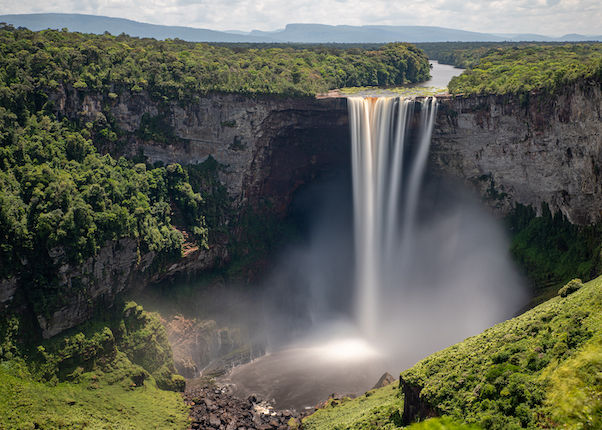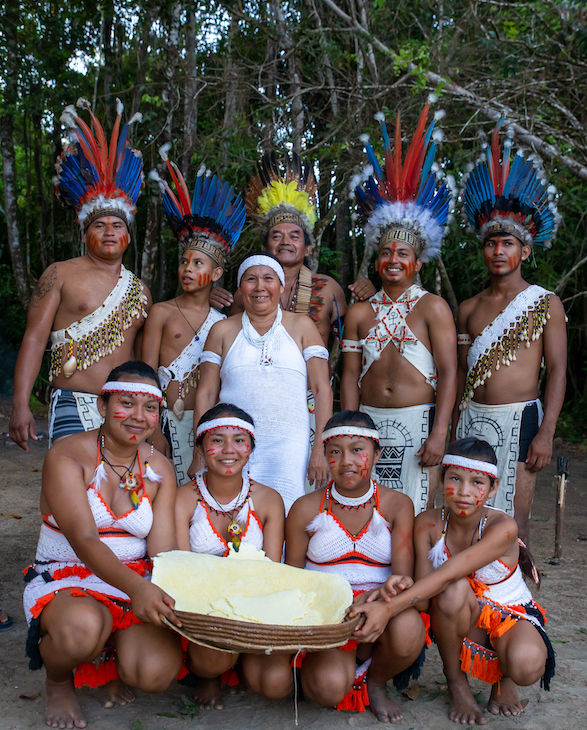Natural and Cultural Attractions in Guyana
- Green Traveller

- Apr 8, 2021
- 6 min read
Updated: Jun 19, 2024
Nature stars in Guyana: its varied habitats – from lush rainforest and endless savannahs to rugged mountains, thundering cataracts, snaking rivers and golden beaches – and their diverse residents provide the big draws. Very big: on a wildlife safari you’re likely to meet giant river otters and anteaters, capybara and arapaima – the planet’s largest scaled freshwater fish – Harpy Eagles and, if you’re lucky, jaguar, as well as encountering one of the largest single-drop waterfalls in the world, Kaieteur Falls. But woven into this rich natural tapestry is a history stretching back through eras of colonisation and immigration – still evident at sites such as Fort Zeelandia and the old wooden buildings of Georgetown – to the arrival of Amerindian peoples perhaps 11 millennia ago. Discover the country’s rich blended heritage, from market and cookery tours in the capital to stays in Makushi villages deep in the wild interior.
Fort Island
The Dutch once presided over the whole colony of Essequibo from this small fluvial island, 16km from the mouth of the Essequibo River. Here, in the mid-18th century, they built the Court of Policy Hall – where decisions were made and enslaved people auctioned – and the current Fort Zeelandia (pictured above), to ward off any invasions from other European powers. Today, though, it’s a peaceful approach across calm waters to reach the island, Fort Zeelandia lies in ruins, though parts of the old ramparts and several canons remain. In better condition is the single-storey red-brick Court, which is the oldest remaining non-military structure in Guyana. Now the Dutch Heritage Museum, it displays numerous maps, charts and artefacts from the colonies, telling the story of the colonisers’ dealings with the people they enslaved and the indigenous peoples.
Essequibo River; nationaltrust.gov.gy/fort-zeelandia-the-court-of-policy/

Georgetown
Guyana’s capital is quite the melting pot, spiced by centuries of colonial back-and-forth, sugar trading, slave history and, of course, even more, deep-rooted indigenous heritage. The cultural melange simmers at the mouth of the Demerara River, at the edge of South America and fringed by the Atlantic. Georgetown is cosmopolitan, sometimes chaotic, faded in parts but never dull. Get a feel for local life at the striking iron-and-steel Stabroek Market, the ‘bizarre bazaar’ where stalls sell everything from fresh fish and electronicsand head to Bourda Market for a colourful cornucopia of Guyanese fruit and veg. For architectural treasures, pay a visit to St George’s Cathedral – allegedly the tallest wooden building in the world – Gothic-style City Hall and the Walter Roth Museum, a handsome 19th-century house containing fine Amerindian art. There are plenty of places for idle ambling, too: Georgetown has numerous parks and a bountiful Botanical Gardens, home to manatee ponds and 200-plus species of birds. Come early evening and promenade along the Sea Wall, the spot for people-watching and cooling breezes.
Iwokrama Rainforest Reserve
The scale and diversity of the Iwokrama International Centre for Rainforest Conservation and Development is hard to comprehend: almost one million acres of teeming, tweeting, roaring, overflowing unspoiled wilderness. Run as a pioneering not-for-profit base for ecotourism, research and sustainable land management for a quarter of a century, it is one of the most pristine places on the planet. Visits to the dense forests might yield encounters with giants: capybara (the largest rodent), arapaima (the largest scaled freshwater fish), black caiman (South America’s biggest crocodilian), giant river otters, giant river turtles and jaguar (the Western Hemisphere’s largest cat). Climb to the canopy walkway for a thrilling introduction to the upper levels of the forest. Iwokrama is the land of the Makushi, who hunted, fished and gathered food across this rich landscape for countless generations. You’ll discover scenes from their lives depicted in petroglyphs, and hear stories from Makushi people who work in Iwokrama today. Various eco-lodges provide bases for exploring well-preserved stretches of this lush forest. iwokrama.org

Kaieteur National Park and Kaieteur Falls
In a land of giants, the most monumental experience in Guyana is surely Kaieteur Falls – a thundering cataract where the coffee-hued Potaro River plunges 226m into a rocky gorge. Twice the height of Victoria Falls and more than four times the height of Niagara, this is reputedly the tallest single-drop waterfall in the world. But though its sheer size and volume captures the attention, don’t ignore the surrounding 627km2 of lush rainforest, bustling with biodiversity – Kaieteur National Park. Wildlife-watchers are in paradise, spotting hundreds of bird species including the vividly coloured Guianan cock-of-the-rock, the white-collared swifts that flit behind the falls, and vibrant parrots including several types of macaws. You might also encounter dazzling blue morpho butterflies and the golden frogs that hide away inside giant tank bromeliads.
Kanuku Mountains Protected Area
The text for Kaieteur is repeated here, instead of the original copy. The correct text should be:
Soaring up to 1100m above the Rupununi savannah and adjacent rainforest, the Kanuku Mountains represent a real ‘lost world’ – a remote, geologically ancient range hosting biological curiosities that reputedly inspired Arthur Conan-Doyle’s ripping adventure yarn. The protected area, spanning over 6000km2, is one of this wildest of countries most-wild regions, a biodiversity hotspot that’s home to 60% of Guyana’s bird species – no wonder the name comes from the Wapishana word meaning ‘rich forest’. The varied habitats support a range of species – spy harpy eagles, jaguars, armadillos, giant river otters, river turtles, giant anteaters and more than 80 types of bat.
Shell Beach Protected Area
The clue is in the name: this swathe of coastline stretching for over 120km along Guyana’s far north-western shore comprises unimaginable numbers of shell fragments. That would be extraordinary enough on its own, but the beach is merely one of diverse marine and terrestrial ecosystems. You’ll find mudflats, seasonally flooded savannah and extensive coastal and riverine mangroves used as nurseries for many of the 59 fish species found in the area. The birdlife is dazzling – and not just the bright scarlet ibis, American flamingos, toucans and macaws. More than 250 coastal and migratory bird species have been spotted within this amazing area. Add West Indian manatees, Guiana dolphins, jaguars and four species of endangered sea turtles that clamber out onto the sand to nest between February and August, then you’ve got a spectacular wildlife destination.
Orinduik Falls
Compared to the majesty of Kaieteur , Orinduik Falls – close to the Brazilian border in Guyana’s central west – are more like a natural water park. Stretching over 150m across, the Ireng River tumbles 25m down over a cluster of red jasper steps and terraces creating natural bubble-fizzing pools that are as soothing as a Jacuzzi. This is the ideal spot to relax and admire the grass-clad foothills of the pristine Pakaraima Mountains. A visit is easily combined on a day-trip from Georgetown taking in both sets of falls, or flying direct from Georgetown.
Savannahs of the North and South Rupununi
Guyana’s Wild South-West is a vast tranche of grassland flanked by pristine rainforest and divided into north and south by the Kanuku Mountains. This is cowboy country: vaqueros drive cattle across sprawling ranches, offering opportunities to get in the saddle and ride alongside these hardy characters, or whoop to the displays at the Rupununi Rodeo around Easter. But the region is nothing if not diverse. It’s studded with pioneering eco-lodges, many community-run and boasting their own wildlife specialties – special mention goes to the giant river otters and anteaters of Karanambu, but there’s plenty more to see besides. This is also the place to immerse yourself in indigenous culture – learn to cook spicy pepper pot or crunchy farine, a favourite dish made with cassava, and slow down to the sleepy pace of traditional village life.
The Essequibo River Circuit & Lake Capoey
Guyana’s largest river snakes over 1000 miles north from its source in the the Acarai Mountains, near the border with Brazil, through rainforest, over waterfalls and past bustling wildlife to reach the Atlantic Ocean. At its northern extremity, it widens into a broad estuary studded with islands, making a day tour of its historic, cultural and natural highlights easily accessible from capital Georgetown, just to the east. Travellers on the Essequibo Circuit typically visit Fort Island’s Court of Policy Hall and ruined Fort Zeelandia, both dating from the mid-18th century, before continuing to one or more resort islands such as Hurakabra, Aruwai White H2O Water Resort, Sloth Island and Baganara Island Resort. Tag on a visit to Lake Capoey, where a boat ride to the Capoey Missions offers a chance to experience low-key Amerindian culture.

Indigenous communities
Wildlife conservation, eco-tourism and traditional culture overlap in Guyana; many indigenous villages manage or work at eco-lodges, and welcome travellers to discover timeless lifestyles, food and heritage. This is typified in the Rupununi Savannahs, where the village of Yupukari is a shining example: here, Wapishana and Makushi peoples have taken on oversight of village concerns, development and conservation work, partnering with researchers to share knowledge and develop capacity for wildlife conservation. Local guides know their environment best, guaranteeing wonderful wildlife encounters for nature-loving travellers.Best, though, is the chance to learn about daily life – for example, the nine uses of cassava, from making bread to preserving meat and even brewing a kind of beer.
For where to stay in Guyana and adventure activities, see our Green Traveller's Guide to Guyana



Comments